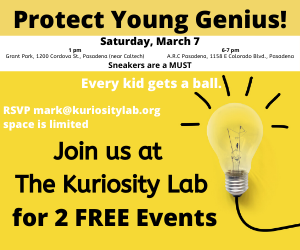What is the Kuriosity Lab?
For more than 15 years, I had worked with at-risk youth as a teacher, curriculum developer and founder/director of an alternative school. Seven years ago, one of my former students offered to fund a learning experiment that I was daydreaming about. He, like so many of his peers, was talented and defiant, so traditional school settings were stifling and often irrelevant to him. So, we created a nonprofit, the Kuriosity Lab, to examine this idea: can young people discover and develop their authentic talents through a different kind of education? In other words, what would a curriculum look like if any student chose to pursue the answers to three questions: “Who am I?” “What am I doing here?” and “How do I get there?” That’s what we were curious about.
How did you go about doing that?
We rented a 2,500 square-foot warehouse with 17’ high ceilings. We built a stimulating environment filled with gadgets and equipment relating to science, music, art, nature, theater, movement, and design along with a shop to build things. We invited young people in starting at four years of age through college. We encouraged them to roam the Lab. We pulled out the appropriate material and tools at the different work/play stations (“Patterns,” Connections,”“Light” “Learning How You Learn.” We built a 20’ wide, nearly 17’ high dome with big 8’X8’doors for all kinds of experiments. Oh, yeah, we even had a ballroom of sorts too. It was the home to dozens of different size balls including one that was nine feet high. Kids loved it! A reporter called it “The Willie Wonka Learning Factory.” And a parent could observe what attracted their child’s attention and for how long. It was quite revealing. Once you understand where a student’s interests are, it’s easy to motivate.

We added another twist. Instead of teaching the standard skills traditionally, we taught writing through playing ball; math by using moveable carts we made.
We showed how the Fibonacci sequence connected nature to art, physics, math and music. We did hundreds of experiments playing with light in the darkened dome. Kids, who had been labeled ADD and ADHD, showed high levels of concentration over long periods. We affirmed that once kids discover the joy of learning again, they want to practice. Imagine coming home and telling your mom you’re giving yourself a homework assignment! And when practice is enjoyable, it becomes play. So, by the time a kid left our place, they and their parents had clues as to what kind of activities fascinated them.
I remember watching the concentration of a very active 10-year-old boy who had some difficulty in a “normal” classroom. He would use one of our carts and navigate a course we had set up. He repeatedly tried to break his record while at the same time learning Rate = Distance/Time. Self motivation creates a determined problem solver. Instead of trying to change him to fit something he wasn’t, where he would often fail, we adapted the environment for him to succeed. His mom saw that we were all now on the track to answering the mission’s three core questions.
That’s great, but is there a formula to reach a shy, studious child?
We’re providing an optimal learning environment. According to scientific studies, a safe space—emotionally, mentally, and physically--in an engrossing, stimulating environment is where kids thrive. As a classroom teacher, I found this method to be truly effective. Discipline problems just faded away. Why be a pain to others, when there’s so many ways to enjoyably learn? As different as this method might seem, the Ancient Greeks had their own version over 2500 years previous. They literally coined the term school, and it meant, no kidding, “leisure.” They didn’t do too badly: inventing the Olympics and philosophy, improving geometry and codifying history, math, theater, and science into disciplines.
Any surprises that you encountered?
We learned that IQ, SAT or GPA were secondary to being deeply involved in an activity of choice. In a book entitled Sparks of Genius, the authors claim that the most important factor for success in any adult occupation is to have a self-disciplined hobby when young. Learning moves from repetition and memorization to a more complex intriguing kind of learning. It’s the kind of learning that the brilliant 20th century educator and writer, John Holt advocated. He said learning is simply “figuring things out.” Hobbies challenge you to do that. I found that space when playing ball after school—and even in school during recess and lunch. I used to find peace by throwing a ball against a wall or bouncing it off other objects. It became a meditation and centering device. I loved competing too. Playing a game against a new opponent always propelled me to learn in hyper drive. If I was going to succeed, I had to observe and analyze the opponent’s strengths and weaknesses accurately, execute on my game plan, and see if I had the skill level, and the will, to gain victory. Play is not just child stuff. It is a great way to solve problems. Our first line of defense, air force pilots, learn to fly their jets first through simulation or play. Even Plato thought that you could learn more about a person in an hour of play than a year’s worth of conversation.
Can you give another example of this method of learning basic skills?
We use questions. We ask what the student is curious about, and a learning experiment is born. We’ve asked, “What makes for an educated human? Students respond with answers we’ve never thought of, so we’re learning and growing too. “What is the art of engineering?” or, “U.S.History through Music.” These activities give students a practical place to apply research and writing skills like outlines or essays that are often hard to focus on in a purely academic setting.
We use questions to open doors to new areas that the student may not know or thought about. Since we have an idea of their previous interests, we feed them according to those interests. And every now and then toss them a pitch that has no seeming relation to them at all—and see what happens. But unfortunately, the vast majority of students across the country are not being challenged. The New York Times published an article last March where researchers found that 68% of all high school juniors describe themselves, first and foremost, as bored. What a loss! And that doesn’t take into account the cynicism they develop towards school and learning. When you learn about the study that NASA and University of Arizona conducted, where they discovered that 98% of five year olds are genius problem solvers and only 12% of them still are ten years later, it’s depressing. So, the Kuriosity Lab is on the road to demonstrate a different, and more effective way to learn. Our sense of curiosity can be reclaimed. Science tells us this is true.
We’ve also just released our latest experiment: an online, sci-fi mystery for teens who don’t usually enjoy reading. In addition to a good story, we ask questions that lead the main character and the reader to clues as to their authentic selves. There’s no charge as we’ve received a grant: https://kuriositylab.org/dodecahedron-mystery/
So, if you want a first-hand experience in this way of learning, we will be having two events on Saturday, March 7that 1pm at Grant Park, and 6 pm at ARC 1158 E Colorado in Pasadena. Every kid will receive a genuine Spaldeen ball and a Kuriosity Lab wristband too.
 |





